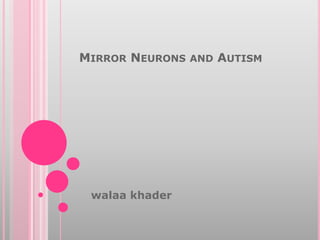
Mirror Neuron and Autism Brain Development
- 1. MIRROR NEURONS AND AUTISM walaa khader
- 2. HOW DO WE STUDY THE BRAIN? fMRI brain scanners let us see which 'brain areas' are active for different tasks
- 3. WHY DO PSYCHOLOGISTS STUDY AUTISM? People with autism have a different way of understanding the world and interacting with the world We want to know how & why So what do we know already?
- 5. The brain stem of a person with autism is shorter than a normal brain stem the structures at the junction of the pons and the medulla are closer to the structures of the lower medulla. It is as though a band of tissue were missing. The brain stem of a person with autism also did not have the superior olive. the facial nucleus is smaller than normal.
- 6. PEOPLE IN: WITH AUTISM OFTEN HAVE TROUBLE Communication and Socialization Empathy(Understanding and being aware of the feelings of others.) Physical contact. Speech. They may learn clever ways to compensate for this Some people with autism are exceptionally good at drawing or maths or music … Many are good at seeing things in detail
- 7. STUDYING THE MIRROR SYSTEM IN AUTISM Mirror neurons are cells that fire during both the doing and watching of a specific action. They have been linked to many behaviors and abilities, from empathy to learning by imitation, as well as implicated in conditions such as autism.
- 8. IS A DYSFUNCTIONAL MIRROR NEURON SYSTEM RESPONSIBLE FOR THE SYMPTOMS OF AUTISM?
- 9. WHAT IS THE BROKEN MIRROR? The mirror system might be abnormal in autism because: children with autism don’t imitate people much some of the functions of the mirror system overlap with the difficulties seen in autism language can develop slowly in children with autism
- 10. there is very little good evidence to support broken mirror hypothesis 1.GOAL DIRECTED IMITATION 3-6 year olds imitate goals not means Revealed by hand errors on cross-body trials Good imitation on all other trials Do children with ASD show the same pattern of errors? Test 26 children with ASD and 25 typical children Bekkering, et al, 2000 Gattis et al, 2002
- 11. GOAL DIRECTED IMITATION 4 asd hand errors typically developing 2 0 same side cross body both sides • Both groups replicate Bekkering et al • No problems with goals in children with ASD
- 12. CONCLUSIONS FROM STUDY 1 Children with autism can imitate goals when explicitly asked to do so This suggests they do NOT have a broken mirror system This means that children with autism can learn through imitation, but we need to explicitly ask them to imitate us
- 13. 2.RAMACHANDRAN AND EXPERIMENT OBERMAN they used electroencephalography (EEG) to test children’s brainwaves while doing and watch actions. Results: For most children, the same brainwaves were detected whether they were doing or watch a specific action. However, for children with ASD, brainwaves were only detected when they were doing an action and not detected when they were watching someone else do the same action, or even when they were imitating another’s action
- 14. This finding supports the "broken mirror hypothesis" and clearly depicts the relationship between mirror neurons and the poor social skills observed in children with ASD (Ramachandran & Oberman, 2006). Since mirror neurons systems are responsible for humans’ ability to understand and mimic other peoples’ behavior, the lack of this skill within persons with ASD can be refer to an impaired mirror neuron system.
- 15. 2. The "Broken Mirror Hypothesis" claims that persons with ASD have impairments to their mirror neuron system (Press, Richardson & Bird, 2010) 3. The dysfunction of the mirror neuron system is a main cause of the poor social skills in persons with Autism (Marsh & Hamilton, 2011). 4.some studies actually show that some individuals with ASD have functioning mirror neurons systems (Fan Decety, Yang, Liu, & Yawei, 2010) and believe that there is still much to learn about the "broken mirror hypothesis".
- 16. MIRROR NEURON SYSTEM IN AUTISM: BROKEN OR JUST SLOWLY DEVELOPING? a new study published inBiological Psychiatry reports that the mirror system in individuals with autism is not actually broken, but simply delayed. Dr. Christian Keysers, lead author on the project, detailed their findings, "While most of us have their strongest mirror activity while they are young, autistic individuals seem to have a weak mirror system in their youth, but their mirror activity increases with age, is normal by about age 30 and unusually high thereafter."
- 17. THIS GRAPH SHOWS THE RELATIONSHIP BETWEEN AGE AND MIRROR ACTIVITY FOR A NORMAL BRAIN AND ONE WITH AUTISM. (CREDIT: IMAGE COURTESY OF ELSEVIER)
- 18. Ramachandran, V.S., & Oberman, L., M. (2006). Broken mirrors: A theory of Autism. Scientific American, 17, 20-29. doi:10.1038/scientificamerican0607-20sp Press, C., Richardson, D., & Bird, G. (2010). Intact imitation of emotional facial actions in autism spectrum conditions. Neuropsychologia, 48, 3291–3297. doi:10.1016/j.neuropsychologia. 2010.07.012 Marsh, L.E., & Hamilton, C. (2011). Dissociation of mirroring and mentalising systems in autism. Neuroimage, 56, 1511-1519. doi:10.1016/j.neuroimage.2011.02.003
- 19. Fan, Y.T., Decety, J., Yang, C.Y., Liu, J.L., & Yawei, C. (2010). Unbroken mirror neurons in autism spectrum disorders. Journal of Child Psychology and Psychiatry. 51(9), 981-988. Dr. Christian Keysers .May 5, 2011 . Biological Psychiatry www.AutismResearchNottingham.org